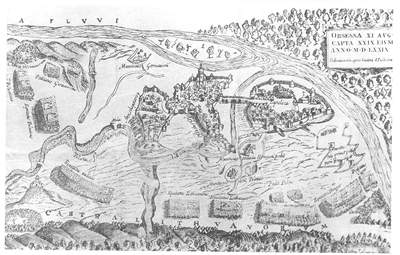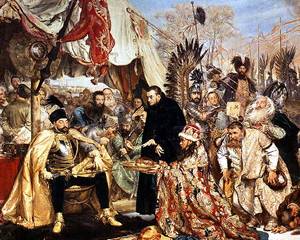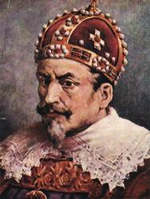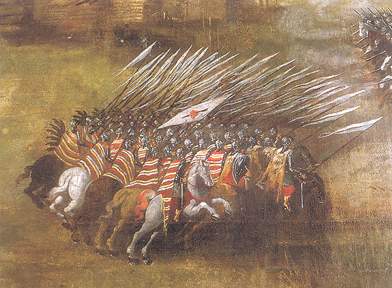|

Part
1 - from
1454 to 1510
Part
2 - from
1512 to 1577
Part
3 - from
1577 to 1618
Part
4 - from
1618 to 1647
Part
5 - from
1648 to 1655
Part
6 - from 1655 to 1660
Part
7 - from
1660 to 1672
Part
8 - from
1672 to 1699
|
|
1577 to 1618
(links to map of Poland)
1577-1582 War with Muscovy
 Batory
now turned East, where Ivan IV (the terrible) had taken advantage
of the Gdansk rebellion and invaded Livonia. By the autumn of 1577
he had captured most of it, except Riga and Rewel. Although Sweden
assisted Poland in capturing Weden (October 1578) they would not
agree to a formal alliance, preferring to await, and hopefully profit
from, any outcome. Batory
now turned East, where Ivan IV (the terrible) had taken advantage
of the Gdansk rebellion and invaded Livonia. By the autumn of 1577
he had captured most of it, except Riga and Rewel. Although Sweden
assisted Poland in capturing Weden (October 1578) they would not
agree to a formal alliance, preferring to await, and hopefully profit
from, any outcome.
In 1579 Batory declared
war and with 22,000 men targeted Polock for capture . His plan was
to drive a wedge between Muscovy and Livonia. He reached Polock
on the 11th of August and took it by the end of the month. Batory
victoriously returned to Wilno having regained a region lost to
Muscovy during the reign of Zygmunt August.
In 1580 larger forces were gathered (29,000), targeting
Wielkie Luki, a strategic stronghold. A smaller diversionary force
was sent to Smolensk, while the main army reached
Wielkie
Luki on 26th August, storming it on 4th September. 
The following year Batory had to give up his plan to strike
directly at Moscow due to the lack of allocated funds. Instead,
with 31,000 men he marched on Pskov,
a near impregnable fortress with a strong garrison. Initial successes
were finally repulsed and the siege became a blockade. In the terrible
winter of 1581-2 the army would have mutinied without the iron will
of the Chancellor Zamojski. In 1582 Ivan surrendered the whole of
Livonia and Polock in return for the lands occupied by Batory. He
had lost some 300,000 men, with the Poles capturing 40,000. During
the campaigns independent Polish detachments
had roamed deep into enemy territory causing havoc and directly
threatening the Tsar.
 Stefan
Batory, amongst the Stefan
Batory, amongst the
greatest of Polish Kings,
dies in 1586.
1587-1588 War with Austria
In the next election there was a conflict between the rebellious
Zborowski family and the powerful Chancellor Jan Zamojski. The Zborowski's
attempted to take matters into their own hands and urged Archduke
Maximillian to take the crown. In September 1587, together with
an army, Maximillian entered Poland but was repulsed at Krakow by
Zamojski. The following year in January the Chancellor, with 3,700
cavalry and 2,300 infantry, crushed the Austrian forces, of 2,600
cavalry, 2,900 infantry and 8 cannon, at Byczyna
(24 January 1588) capturing the Archduke. He
was not released until Austria abandoned all claims to the Polish
throne.
 Zygmunt
(Sigismund) III Vasa is elected King Zygmunt
(Sigismund) III Vasa is elected King
in 1587. Son of the Swedish king John III
and Catherine Jagiellonian.
Tartar attacks
In July 1589 Tartars invaded Lvov and Tarnopol, but were driven
out and pursued by Cossack forces.
In 1593 Zygmunt III went to Stockholm in an attempt
to gain his throne, in his absence the Cossacks stirred up the South
by invading Turkish territory and Zamojski was compelled to march
against the Crimean tartars and prevent Turkish retaliation.
1595-1600 Wars in Moldavia and Wallachia
In 1595 the Chancellor led a small army of 8,000 veterans into Moldavia,
placing Jeremy Mohila, as Poland's vassal. When a combined Turkish-Tartar
force attacked them at Cecora,
Zamojski withstood a three day siege (17-20 October) and managed
to obtain agreement from the Turks of the Treaty of Cecora, thereby
recognising Mohila as Hospodar.
In 1596 King Zygmunt III transfers
the Capital of Poland
from Krakow to Warsaw (Warszawa).
In 1599 Hospodar Michael of Wallachia drove out Hospodar
Mohila and the following year Zamojski returned, marched into Wallachia
and defeated Michael on 19th September 1600.
1600-1611 War
with Sweden
In 1598 Zygmunt left for Sweden with 5,000 men, without official
Polish assistance, but was defeated at Linkoping by his Uncle Charles
of Sudermania. Charles made himself master of all Sweden and forced
Finland to submit to his authority. In 1600 he led troops into Estonia
which still recognised Zygmunt, and continued the war into Polish
Livonia. So instead of the election of a Swedish king bringing the
two countries closer it led to war, which was to last, intermittently,
for sixty years.
 In
1601 and 1602 after initial successes the Swedes were driven from
most of Livonia. Radziwill achieved a decisive victory over greater
enemy forces at Kokenhausen
(24th June 1601). Though Zygmunt continued his claims for the
Swedish Crown, he did not provide any assistance in the form of
troops. In the 1604 campaign Chodkiewicz's outnumbered forces comprehensively
defeated the Swedes at Bialy
Kamien (25 September 1604). In 1605, after difficulties at home,
Charles resumed the war in Livonia. The weak Polish-Lithuanian forces
under Chodkiewicz achieved a startling victory on at Kircholm,
(27 September 1605) totally destroying the three times larger enemy.
Significant advantage could not be taken by the unpaid Polish forces
and when rebellion against Zygmunt appeared in Poland Charles was
able to return to Livonia and regain many strongholds. The Swedish
had also learnt from their past experiences and they avoided battle,
remaining in towns and castles. However returning Polish forces
were still able to regain much of what had been lost and the conflict
dissipated with both participants' attention being turned to the
turmoil in Muscovy. In
1601 and 1602 after initial successes the Swedes were driven from
most of Livonia. Radziwill achieved a decisive victory over greater
enemy forces at Kokenhausen
(24th June 1601). Though Zygmunt continued his claims for the
Swedish Crown, he did not provide any assistance in the form of
troops. In the 1604 campaign Chodkiewicz's outnumbered forces comprehensively
defeated the Swedes at Bialy
Kamien (25 September 1604). In 1605, after difficulties at home,
Charles resumed the war in Livonia. The weak Polish-Lithuanian forces
under Chodkiewicz achieved a startling victory on at Kircholm,
(27 September 1605) totally destroying the three times larger enemy.
Significant advantage could not be taken by the unpaid Polish forces
and when rebellion against Zygmunt appeared in Poland Charles was
able to return to Livonia and regain many strongholds. The Swedish
had also learnt from their past experiences and they avoided battle,
remaining in towns and castles. However returning Polish forces
were still able to regain much of what had been lost and the conflict
dissipated with both participants' attention being turned to the
turmoil in Muscovy.
1606-1607 Zebrzydowski
Rebellion.
A large number of nobles revolted against the King Zygmunt III Vasa,
a Swede, who they felt concerned himself too much with regaining
his Swedish throne. The nobles took to arms but were defeated by
a heavily outnumbered Royal army led by the two loyal Hetman's Zolkiewski
and Chodkiewicz at Guzow
(6 July 1607).
1610-1619
War with Muscovy
After the death of Ivan the Terrible Muscovy was in turmoil with
the arrival of various false Demetrius'. Significant numbers of
Polish adventurers were recruited by the second false Demetrius.
However the Commonwealth did not involve itself
until Prince Vasili Szujski became Tsar. It was Szujski who in the
1606 coup instigated the massacre of 500 Poles in Moscow, he also
signed an alliance with Sweden in February 1609 and 5,000
Swedish troops joined the Muscovite army. This was a threat that
Poland could not ignore and Hetman Zolkiewski left with 13,000 troops
intending to march directly on Moscow. He was however overruled
by Zygmunt who wanted to besiege the powerful fortress at Smolensk. A combined 30-40,000 Muscovite-Swedish army was sent to relieve
Smolensk, but they were decisively defeated by Zolkiewski's 5,000
force at Kluszyn
(Klushino) (4th July 1610) and Szujski was removed
by a court rebellion and the Poles moved to Moscow unopposed.
A combined 30-40,000 Muscovite-Swedish army was sent to relieve
Smolensk, but they were decisively defeated by Zolkiewski's 5,000
force at Kluszyn
(Klushino) (4th July 1610) and Szujski was removed
by a court rebellion and the Poles moved to Moscow unopposed.
Zolkiewski entered Moscow and
his conciliatory attitude enabled Zygmunt's son Wladyslaw to be
elected Tsar. However Zygmunt did not feel bound by Zolkiewski's
agreements with Moscow and Zolkiewski returned to Poland in October
1610 leaving a garrison in Moscow. The view of the Muscovites turned
against the foreign intruders and in March 1611 they attacked the
garrison and burned three quarters of the city, forcing the Poles
to take refuge in the Kremlin where they endured a nineteen month
siege. In June 1611 Smolensk capitulated to the Poles. But Zygmunt's
poorly organised relief of the Moscow garrison failed to reach them
and they were starved into surrender. The overall campaign was a
failure, though the Smolensk and Seversk regions, lost since the
16th century, were regained.
On returning to Poland Zygmunt
found in disorder, with thousands of unpaid and undisciplined soldiers
roaming and pillaging the lands, while his military operations were
heavily criticised. In 1613 the New Tsar
Michael Romanov sent forces to regain Smolensk, while Zaporozhian
Cossacks, withdrawn from the adventures in Muscovy, raided the Ottoman
territories causing protestation from the Turks of Poland's lack
of control of them.
Conflict with
Turkey
In 1615 powerful Polish Magnates attempted to install their candidate
in Moldavia. Their initial success caused the Ottomans to stir,
sending an force to meet the private army of the magnates. After
defeating them they approached Poland but met an entrenched Polish
army of Zolkiewski at Busza.
Neither side wanted war and previous agreements were reaffirmed
in 1617.
Continuation
of Conflict with Muscovy
Once peace was confirmed with Turkey, Wladyslaw invaded Russia in
an attempt to regain his Tsardom, but he achieved nothing. In January
1619 the treaty of Deulina was concluded which left
Smolensk, Siewiersk and Czernihow to Poland.
 3 3

|
|


Page 3

|

![]()



 Zygmunt
(Sigismund) III Vasa is elected King
Zygmunt
(Sigismund) III Vasa is elected King 
 In
1601 and 1602 after initial successes the Swedes were driven from
most of Livonia. Radziwill achieved a decisive victory over greater
enemy forces at
In
1601 and 1602 after initial successes the Swedes were driven from
most of Livonia. Radziwill achieved a decisive victory over greater
enemy forces at 